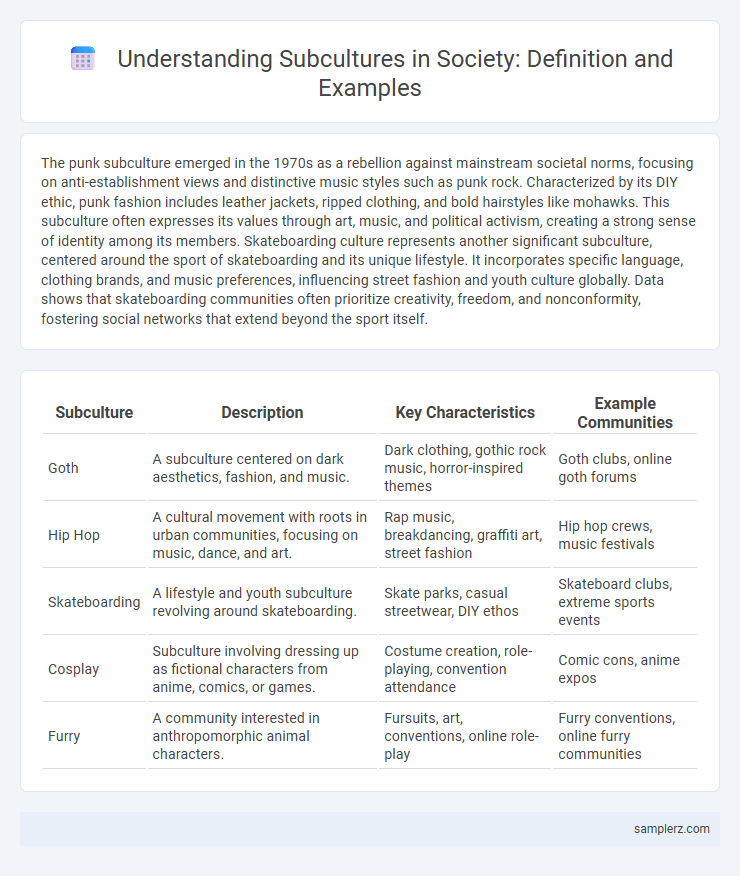The punk subculture emerged in the 1970s as a rebellion against mainstream societal norms, focusing on anti-establishment views and distinctive music styles such as punk rock. Characterized by its DIY ethic, punk fashion includes leather jackets, ripped clothing, and bold hairstyles like mohawks. This subculture often expresses its values through art, music, and political activism, creating a strong sense of identity among its members. Skateboarding culture represents another significant subculture, centered around the sport of skateboarding and its unique lifestyle. It incorporates specific language, clothing brands, and music preferences, influencing street fashion and youth culture globally. Data shows that skateboarding communities often prioritize creativity, freedom, and nonconformity, fostering social networks that extend beyond the sport itself.
Table of Comparison
| Subculture | Description | Key Characteristics | Example Communities |
|---|---|---|---|
| Goth | A subculture centered on dark aesthetics, fashion, and music. | Dark clothing, gothic rock music, horror-inspired themes | Goth clubs, online goth forums |
| Hip Hop | A cultural movement with roots in urban communities, focusing on music, dance, and art. | Rap music, breakdancing, graffiti art, street fashion | Hip hop crews, music festivals |
| Skateboarding | A lifestyle and youth subculture revolving around skateboarding. | Skate parks, casual streetwear, DIY ethos | Skateboard clubs, extreme sports events |
| Cosplay | Subculture involving dressing up as fictional characters from anime, comics, or games. | Costume creation, role-playing, convention attendance | Comic cons, anime expos |
| Furry | A community interested in anthropomorphic animal characters. | Fursuits, art, conventions, online role-play | Furry conventions, online furry communities |
Understanding Social Subcultures
Social subcultures such as goths, hip-hop enthusiasts, and gamers exhibit distinct values, styles, and behaviors that differentiate them from mainstream culture. Understanding these groups requires analyzing their shared symbols, language, and rituals that foster a sense of identity and community. Studying social subcultures provides insights into how individuals negotiate belonging and express resistance within broader societal structures.
Characteristics of Subcultural Groups
Subcultural groups exhibit distinct values, norms, and behaviors that differentiate them from the dominant culture, often emphasizing unique styles, language, and rituals. These groups foster strong social bonds and a sense of identity among members through shared interests or experiences, such as punk music, skateboarding, or gaming communities. Their characteristics include resistance to mainstream norms, creativity in self-expression, and the formation of alternative social structures.
Youth Subcultures: Trends and Influence
Youth subcultures such as punk, goth, and hip-hop have significantly shaped fashion, music, and social attitudes since the late 20th century. These groups express identity and resistance through distinctive styles and language, influencing mainstream culture and shaping societal norms. Digital platforms amplify their reach, allowing rapid trend dissemination and global connectivity among youth communities.
Music and Fashion Subcultures
The punk subculture, originating in the 1970s, is characterized by its distinctive music style featuring fast-paced, rebellious punk rock and a unique fashion sense that includes leather jackets, ripped jeans, and bold hairstyles like mohawks. Hip hop subculture combines rap music with streetwear fashion elements such as baggy pants, oversized hoodies, and sneakers, reflecting urban cultural identity and social commentary. Goth subculture blends dark, melancholic music genres like gothic rock with fashion emphasizing black clothing, dramatic makeup, and Victorian-inspired accessories.
Online Subcultures in the Digital Age
Online subcultures in the digital age manifest as distinct communities centered around shared interests like gaming, anime, or cryptocurrency, often using platforms such as Reddit, Discord, and TikTok for interaction. These digital subcultures foster identity formation and social bonding through unique language, memes, and rituals, shaping modern social dynamics. The rise of influencer culture and algorithm-driven content further amplifies the visibility and impact of these online groups globally.
LGBTQ+ Subculture and Social Acceptance
The LGBTQ+ subculture exemplifies a vibrant social group defined by shared experiences, identities, and advocacy for equal rights. This subculture fosters community through pride events, art, and activism, contributing to broader societal awareness and acceptance. Social acceptance of LGBTQ+ individuals has grown significantly, yet challenges remain in achieving full equality and inclusivity across various cultures and regions.
Urban vs. Rural Subcultural Dynamics
Urban subcultures often revolve around innovation, diversity, and fast-paced lifestyles, featuring distinct music genres, fashion trends, and artistic expressions. In contrast, rural subcultures emphasize tradition, community values, and slower, nature-integrated living, preserving local customs and agricultural practices. These urban and rural subcultural dynamics highlight the complex interplay between environment, social identity, and cultural evolution.
Political Subcultures: Shaping Social Movements
Political subcultures, such as the environmentalist and civil rights movements, significantly shape social dynamics by influencing collective behavior and public policy. These groups often challenge dominant societal norms through protests, advocacy, and grassroots organizing, fostering political awareness and engagement. The evolution of political subcultures reflects shifting social values and contributes to transformative social change on both local and global scales.
Globalization’s Impact on Subcultures
Globalization accelerates the blending of cultural elements, leading to the emergence of hybrid subcultures such as K-pop fandoms that merge Korean pop culture with global fan practices. These subcultures leverage digital platforms like YouTube and TikTok to expand their reach, influencing lifestyle, fashion, and language across continents. The increased connectivity fosters cultural exchange but also raises challenges in preserving localized traditions within global networks.
Subcultures and Mainstream Society Interaction
Punk subculture challenges mainstream societal norms through distinctive fashion, music, and anti-establishment attitudes, fostering both conflict and cultural influence. This interaction prompts the mainstream to adopt elements like punk fashion and music styles, demonstrating cultural assimilation. Such dynamics highlight the ongoing negotiation between subcultural identity and societal acceptance.

example of subculture in social Infographic
 samplerz.com
samplerz.com